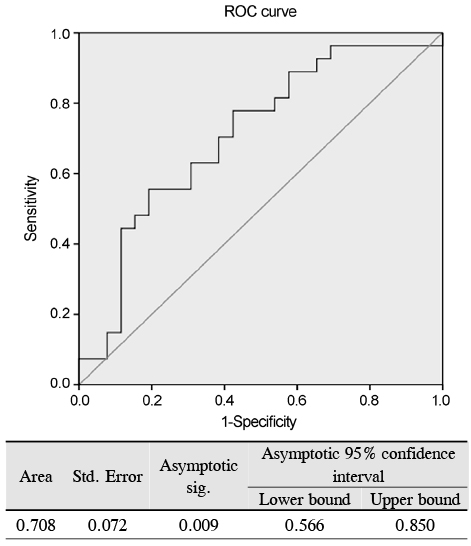J Korean Ophthalmol Soc.
2017 Sep;58(9):1023-1030. 10.3341/jkos.2017.58.9.1023.
Comparison of Corneal Higher-order Aberration before and after Excision of Pterygium
- Affiliations
-
- 1Department of Ophthalmology, Yonsei University Wonju College of Medicine, Wonju, Korea. eyedockim@yonsei.ac.kr
- KMID: 2390064
- DOI: http://doi.org/10.3341/jkos.2017.58.9.1023
Abstract
- PURPOSE
To investigate the types of corneal higher-order aberration (HOA) induced by pterygium, residual corneal HOA after pterygium surgery, and correlations between corneal HOA and the length of the pterygium.
METHODS
Fifty-three patients who underwent pterygium excision with conjunctival autograft were enrolled. Corneal HOA was measured by Pentacam® (Oculus Inc., Wetzlar, Germany) preoperatively and 3 months postoperatively in the 6-mm optical zone. Preoperative and postoperative HOAs of eyes with pterygium were compared with HOAs of the fellow eye to evaluate HOAs induced by pterygium and residual HOAs after pterygium surgery. Partial correlation analysis was performed to investigate the relationship between HOAs and the length of pterygium. A postoperative HOA less than 0.35 µm in size was defined as a favorable surgical outcome and the surgical indications were estimated using receiver operator characteristic (ROC) curve.
RESULTS
Horizontal coma, root mean square (RMS) of coma, oblique trefoil, horizontal trefoil, RMS of trefoil, and total HOA were significantly greater in the eye with preoperative pterygium. Three months after pterygium excision, only RMS of coma and total HOA remained significantly greater in eyes with pterygium. Vertical coma, horizontal coma, RMS of coma, and oblique tetrafoil were correlated with pterygium length. Pterygium excision when pterygium length was less than 1.6 mm led to favorable surgical outcomes.
CONCLUSION
Pterygium induced greater than third-order corneal HOAs and these HOAs were corrected via pterygium surgery. Longer pterygium length was associated with larger RMS of coma and larger coma RMS persisted after pterygium surgery. A pterygium length of 1.6 mm should be considered the cutoff for pterygium excision for reducing postoperative corneal HOA.
MeSH Terms
Figure
Reference
-
1. Dushku N, John MK, Schultz GS, Reid TW. Pterygia pathogenesis: corneal invasion by matrix metalloproteinase expressing altered limbal epithelial basal cells. Arch Ophthalmol. 2001; 119:695–706.2. Threlfall TJ, English DR. Sun exposure and pterygium of the eye: a dose-response curve. Am J Ophthalmol. 1999; 128:280–287.3. Hansen A, Norn M. Astigmatism and surface phenomena in pterygium. Acta Ophthalmol (Copenh). 1980; 58:174–181.4. Yasar T, Ozdemir M, Cinal A, et al. Effects of fibrovascular traction and pooling of tears on corneal topographic changes induced by pterygium. Eye (Lond). 2003; 17:492–496.5. Cinal A, Yasar T, Demirok A, Topuz H. The effect of pterygium surgery on corneal topography. Ophthalmic Surg Lasers. 2001; 32:35–40.6. Ozdemir M, Cinal A. Early and late effects of pterygium surgery on corneal topography. Ophthalmic Surg Lasers Imaging. 2005; 36:451–456.7. Lin A, Stern G. Correlation between pterygium size and induced corneal astigmatism. Cornea. 1998; 17:28–30.8. Stern GA, Lin A. Effect of pterygium excision on induced corneal topographic abnormalities. Cornea. 1998; 17:23–27.9. Fong KS, Balakrishnan V, Chee SP, Tan DT. Refractive change following pterygium surgery. CLAO J. 1998; 24:115–117.10. Tomidokoro A, Miyata K, Sakaguchi Y, et al. Effects of pterygium on corneal spherical power and astigmatism. Ophthalmology. 2000; 107:1568–1571.11. Tomidokoro A, Oshika T, Amano S, et al. Quantitative analysis of regular and irregular astigmatism induced by pterygium. Cornea. 1999; 18:412–415.12. Lindsay RG, Sullivan L. Pterygium-induced corneal astigmatism. Clin Exp Optom. 2001; 84:200–203.13. Mohammad-Salih PA, Sharif AF. Analysis of pterygium size and induced corneal astigmatism. Cornea. 2008; 27:434–438.14. Oner FH, Kaderli B, Durak I, Cingil G. Analysis of the pterygium size inducing marked refractive astigmatism. Eur J Ophthalmol. 2000; 10:212–214.15. Villegas EA, Alcón E, Artal P. Optical quality of the eye in subjects with normal and excellent visual acuity. Invest Ophthalmol Vis Sci. 2008; 49:4688–4696.16. Pesudovs K, Figueiredo FC. Corneal first surface wavefront aberrations before and after pterygium surgery. J Refract Surg. 2006; 22:921–925.17. Gumus K, Erkilic K, Topaktas D, Colin J. Effect of pterygia on refractive indices, corneal topography, and ocular aberrations. Cornea. 2011; 30:24–29.18. Zare M, Zarei-Ghanavati S, Ansari-Astaneh MR, et al. Effects of pterygium on ocular aberrations. Cornea. 2010; 29:1232–1235.19. Kwon SM, Lee DJ, Jeung WJ, Park WC. Power ector and aberrations using corneal topographer and wavefront aberrometer before and after pterygium surgery. J Korean Ophthalmol Soc. 2008; 49:1737–1745.20. Gumus K, Topaktas D, Göktaş A, et al. The change in ocular higher-order aberrations after pterygium excision with conjunctival autograft: a 1-year prospective clinical trial. Cornea. 2012; 31:1428–1431.21. Miranda MA, Radhakrishnan H, O'Donnell C. Repeatability of oculus pentacam metrics derived from corneal topography. Cornea. 2009; 28:657–666.22. Swartz T, Marten L, Wang M. Measuring the cornea: the latest developments in corneal topography. Curr Opin Ophthalmol. 2007; 18:325–333.23. Levy Y, Segal O, Avni I, Zadok D. Ocular higher-order aberrations in eyes with supernormal vision. Am J Ophthalmol. 2005; 139:225–228.24. Han HC, Kim JH, Lee DH. The changes of corneal higher-order aberrations after surgery according to pterygium size. J Korean Ophthalmol Soc. 2014; 55:32–39.25. Oie Y, Maeda N, Kosaki R, et al. Characteristics of ocular higher-order aberrations in patients with pellucid marginal corneal degeneration. J Cataract Refract Surg. 2008; 34:1928–1934.26. Smolek MK, Klyce SD. Zernike polynomial fitting fails to represent all visually significant corneal aberrations. Invest Ophthalmol Vis Sci. 2003; 44:4676–4681.
- Full Text Links
- Actions
-
Cited
- CITED
-
- Close
- Share
- Similar articles
-
- Comparison of Refractive Change Measured by Corneal Topography between before and after Pterygium Excision
- Comparison between Anterior Corneal Aberration and Ocular Aberration in Laser Refractive Surgery
- The Changes of Corneal Higher-Order Aberrations after Surgery According to Pterygium Size
- The Effect of Pterygium on Corneal Astigmatism and Visual Acuity
- A Simplified way to Remove the Head of Pterygium



